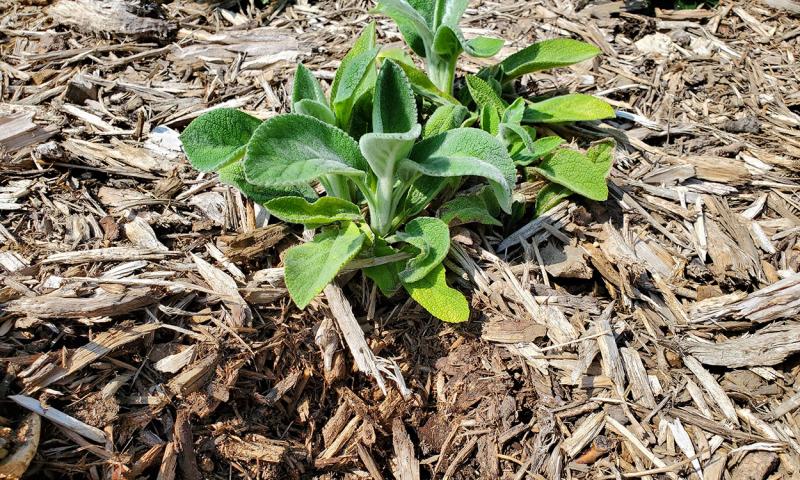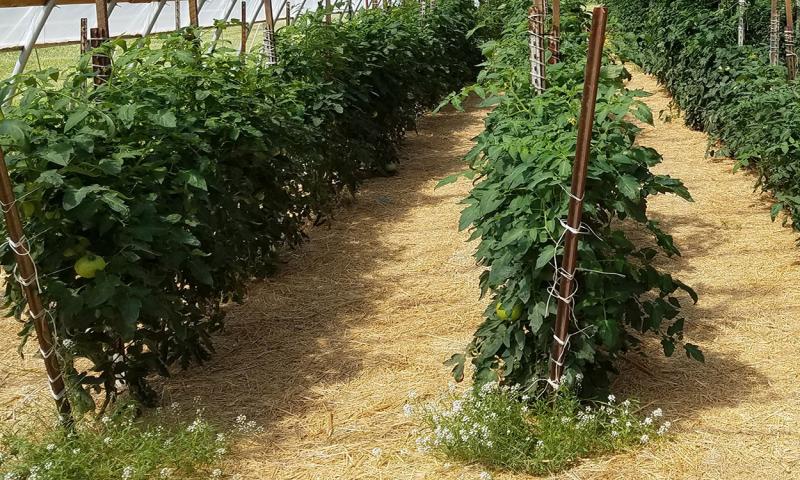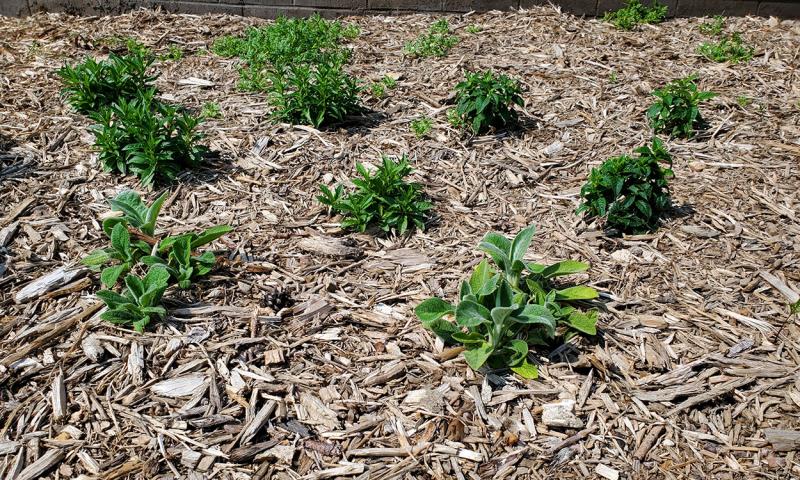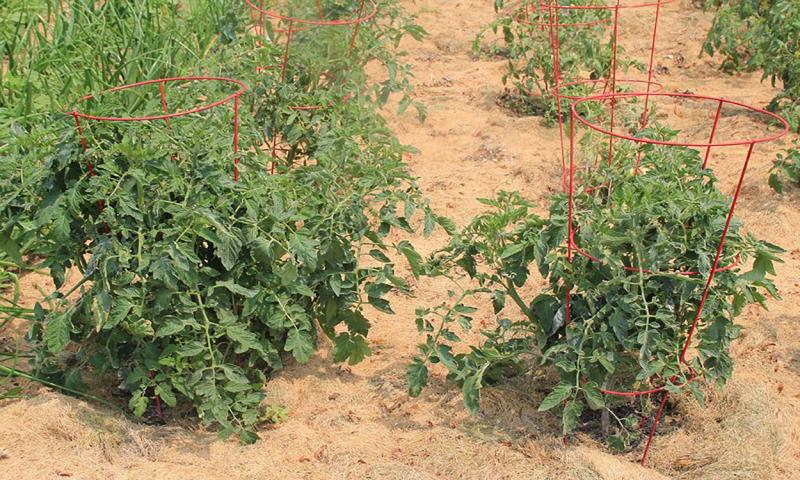
Original article by David Graper, former SDSU Extension Horticulture Specialist and Master Gardener Program Coordinator. Updated by Kristine Lang, SDSU Assistant Professor and Extension Specialist in Consumer Horticulture, and Rhoda Burrows, former SDSU Professor and Extension Specialist in Horticulture.
If you want to reduce time spent in your vegetable and flower gardens watering or pulling weeds, consider mulching the soil surface with an organic material to improve plant health and your enjoyment of the garden. Organic mulches can be sourced from a variety of materials that contribute to soil, plant, system and human benefits. While inorganic mulches, such as black-woven landscape fabric, are a great solution for combatting weeds and can aid in moisture retention, they can raise soil temperatures by several degrees during the heat of summer, which may have unintended consequences for some home gardeners.
Organic mulches can moderate soil temperatures during hot, dry summers; prevent erosion and compaction and enhance water retention during periods of limited rainfall (Figure 1). However, perennial plants that naturally grow in drier conditions should not have a heavy, organic mulch. Organic mulches will break down over time, slowly releasing small amounts of organic nutrients. Mulches can have system benefits, including suppressing pathogens, pests and weeds. With each of these organic mulches, the use of a landscape fabric barrier is not recommended; rather, let the mulch contact the soil surface directly.
Gardeners benefit from using organic mulches by having an improved garden aesthetic and potential time-and-cost savings over time with reduced watering, improved plant health and reduced weeding time. The use of mulch becomes especially important during times of drought. Below are several organic mulch options for vegetable gardens, annual flower gardens and perennial landscape plantings.
Straw and Hay

Straw or hay placed four to six inches thick makes an excellent mulch for vegetable gardens (Figure 2). Hay baled from alfalfa or clover fields will release nitrogen as it breaks down on the soil surface. Ensure that hay is not contaminated with weed seeds. If you use straw, look for a source that is free of both weed and grain seeds. Straw works particularly well as a mulch around potatoes, where you would ordinarily be hilling the potatoes to encourage higher production. Hay or straw mulches can be incorporated into the garden soil at the end of the growing season to allow time for the material to break down and contribute to higher organic matter for next year’s garden planting. Straw and hay mulches left on the soil surface can become habitat for small rodents, and they are not recommended around perennial garden plantings.
Wood Chips

Wood chips are a great mulch for perennial flower landscape plantings along buildings or in standalone gardens (Figure 3). Wood chips can be bought from garden centers, acquired at many municipal waste facilities, or even sourced from local arborists who do tree removals. For established perennial plantings, there is generally no issue with nitrogen tie-up or nutrient deficiencies because of using shredded bark or wood chips. Wood mulches are generally not recommended for annual flower or vegetable gardens where nitrogen tie-up may be a concern, and placement and removal in a seasonal garden may prove difficult. Wood chips around perennial flowers should be to a depth of four to six inches to provide maximum weed control around the plants. Mulch should be placed on soil surfaces that are free of weeds at time of placement (not used to “suffocate” an already weedy garden). Research has demonstrated that wood chip mulch as deep as eight inches can be especially beneficial for weed control and plant establishment in native plant restoration.
Wood mulches should be top-dressed as needed to maintain an appropriate depth; high traffic areas, such as paths through a perennial garden, may require additions of new mulch more frequently. One way to provide an additional nutrient boost to a new garden planting is to spread a layer of compost (one to two inches deep) over the soil surface and then cover this layer with shredded bark or wood chips.
Pine Needles
Pine needles are a light, airy mulch that can be used on annual, perennial and vegetable gardens. Because the needles are smaller and will settle quickly, consider a depth of four to six inches for adequate weed control. The breakdown of needles contributes to some acidification of the soil, which can be beneficial for many garden plants. Pine needles can be sourced from trees in your yard or windbreaks. Never collect pine needles from public lands, such as state or national parks or forests.
Leaves
The use of leaves as a garden mulch requires planning ahead, as the leaves should be shredded or partially decomposed prior to use in the garden. This shredding and decomposition prevents leaves from creating a thick, wet mat on the garden soil and also reduces the chance that dry material will simply blow off the garden surface. Leaves are most appropriate as a vegetable or annual flower garden mulch. Decomposed leaves should be placed two to three inches thick for adequate seasonal weed control. At the end of the season remaining leaves can be incorporated into the garden soil for an addition of organic material that will break down prior to next year’s planting. Avoid using leaves from black walnut trees, as they contain juglone, which may cause issues for many garden plants, especially those in the Nightshade family, such as tomatoes, peppers, eggplants and potatoes.
Grass Clippings

A common, and readily available organic mulch is grass clippings, typically from your own lawn. Grass clippings can work well in annual flower and vegetable gardens (Figure 4). However, grass clippings should be dry (not freshly cut and still green) before they are applied as a mulch. Applying clippings in thin layers so they can dry between applications is one way to avoid issues. Wet grass clippings can mat down and impede water absorption into the soil, while giving off a bad odor and excessive heat due to lack of oxygen penetrating the clippings for proper breakdown of the material. Grass clippings should be placed to a depth of two to four inches and will break down rather quickly in the garden.
Always know the source of your grass clippings before using it as a mulch on your garden. Lawn herbicides can still be present on grass clippings, even weeks after they were applied. Sensitive plants like tomatoes and potatoes can show damage from herbicides, like 2,4-D and Banvel, within just a few days of using contaminated clippings around plants. Generally, it will take one to two months for 2,4-D to break down to a safe level once it has been applied to a lawn. Banvel can take three to 12 months! Some of the other commercial products will need a similar time frame to effectively break down.
While grass clippings can work well as a garden mulch, remember that properly managed grass clippings are a valuable source of organic matter for your lawn itself. If you mow on a regular basis, not removing more than one-third of the grass blade height at one mowing, a regular lawn mower should distribute clippings over the surface of the lawn. These grass clippings will filter down between the grass plants, decompose and contribute to improved soil health for your lawn.
Special thanks to SDSU Extension Master Gardeners Tim Schreiner and Stacy Dreis for serving as volunteer copy editors of this article.
References and Resources:
- Cahill, A. and L. Chalker-Scott. 2015. Does Mulch Improve Plant Survival and Growth in Restoration Sites?.
- Chalker-Scott, L. 2007. Wood Chip Mulch: Landscape Boon or Bane?.
- Jauron, R. 2013. Organic Mulches.
- Relf, D., A. McDaniel, and D. Close. 2020. Mulches for the Home Vegetable Garden.


